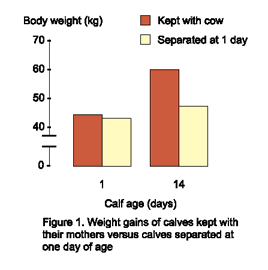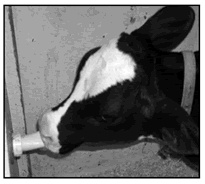On a typical dairy farm calves are separated from their mothers within 24 hours of birth. These young dairy calves are usually moved to individual pens or hutches and fed about 2 litres of milk by bucket twice a day. Recent work at the UBC Dairy Education and Research Centre have shown that even small changes in these calf rearing practices can produce big improvements in calf growth and well being.
Our research started by asking what we can learn from the cow. When kept with her calf, the cow allows it to nursed about 10 times a day. On each occasion, the calf sucks for several minutes consuming about 1 litre of milk.

Over the day, this amounts to approximately 10 litres, or over twice as much milk as is typically provided to calves on commercial dairy farms. Not surprisingly, this increased intake of milk allows the calves to grow rapidly.
As illustrated in Figure 1, calves kept with the cow for the first 2 weeks of life gain weight at nearly four times the rate of bucket-fed calves during the first 2 weeks of life.
While keeping calves with their mothers may not be practical on most dairy farms, the benefits of consuming more milk in smaller but more frequent meals can still be achieved. In several experiments we have provide calves with free access to milk through a nipple drinker (Figure 2)

Calves fed in this way consume twice as much as they are normally given (Figure 3), allowing them to gain weight about twice as fast as those calves fed in conventional manner. The calves fed more milk were no more likely to scour than the traditionally fed calves. The calves fed more milk also made an excellent transition to solid food at weaning, allowing them to maintain their weight advantage over the conventionally fed calves.
Producers can also achieve higher calf weight gains using buckets to feed more milk, more often, but we have fount that nipple based systems are labour efficient, and they allow calves to express their natural desire to suck for their milk. Like calves kept with the cow, those with access to a nipple also tend to divide their daily milk consumption into about 10 meals.
Using nipple systems to provide more milk also facilitates group housing. If properly managed, calves direct their sucking to the nipples, and not to pen mates. Group housing of calve will be the topic of a future Research Report.

In a summary, there can be advantages to the calves and to the producers in giving calves more milk. With increase access to milk calves grow faster, permitting weaning at an earlier age. Under well-managed conditions, increased milk intake does not lead to increased scouring or problems in making the transition to solid feed at weaning. Calves also call when they are hungry, so feeding more milk helps to keep the calf barn much quieter.
Changes in feeding methods can require new equipment and new management skills. Producers interested in feeding their calves more milk should start slowly with just a few calves to develop procedures that work well on their farm. As with feed for any animal, keep a careful eye on the quality and avoid sudden changes in the feeding program. We have found that even very young calves (within their first week of life) can take advantage of more milk. Consider starting off with the youngest calves, after having ensured that they have received colostrum.
To find out more about recent work on dairy calf rearing, please look up this web based article.
Thanks to the dairy industry and others for their support of this research through funding to the Animal Welfare Program by the Dairy Farmers of Canada, the BC Dairy Foundation, the Cattle Industry Development Council, Westgen, members of the BCVMA, the BC SPCA and many others listed at the Animal Welfare Program.
This article is based on research by Mike Appleby, Erin Bell, Bev Chua, Eveline Coenen, Frances Flower, Tamiko Thomas and Joyce van Delen. Dan Weary is Associate Professor in the Animal Welfare Program and can be contacted at: danweary@interchange.ubc.ca
